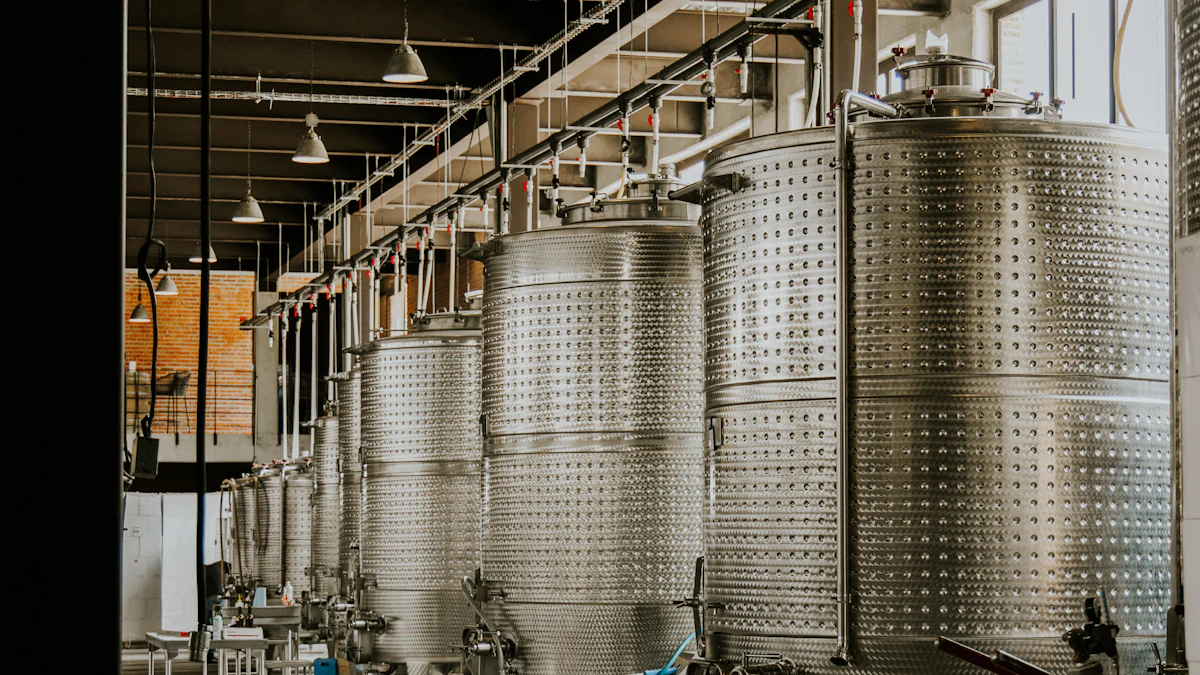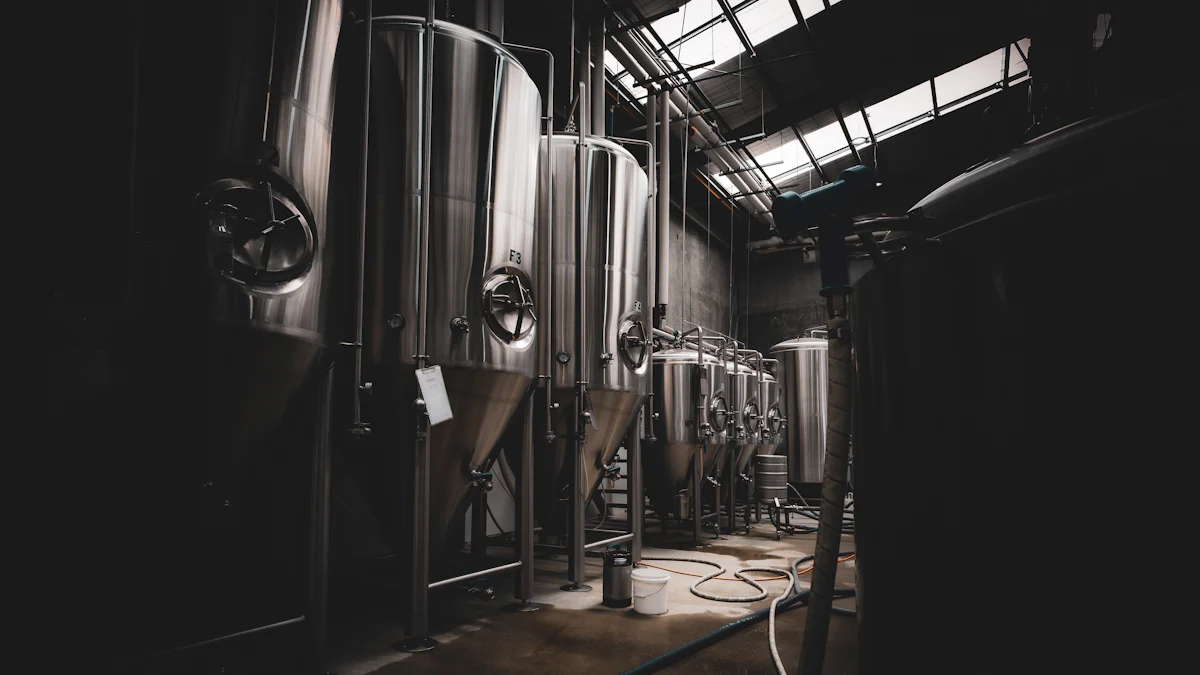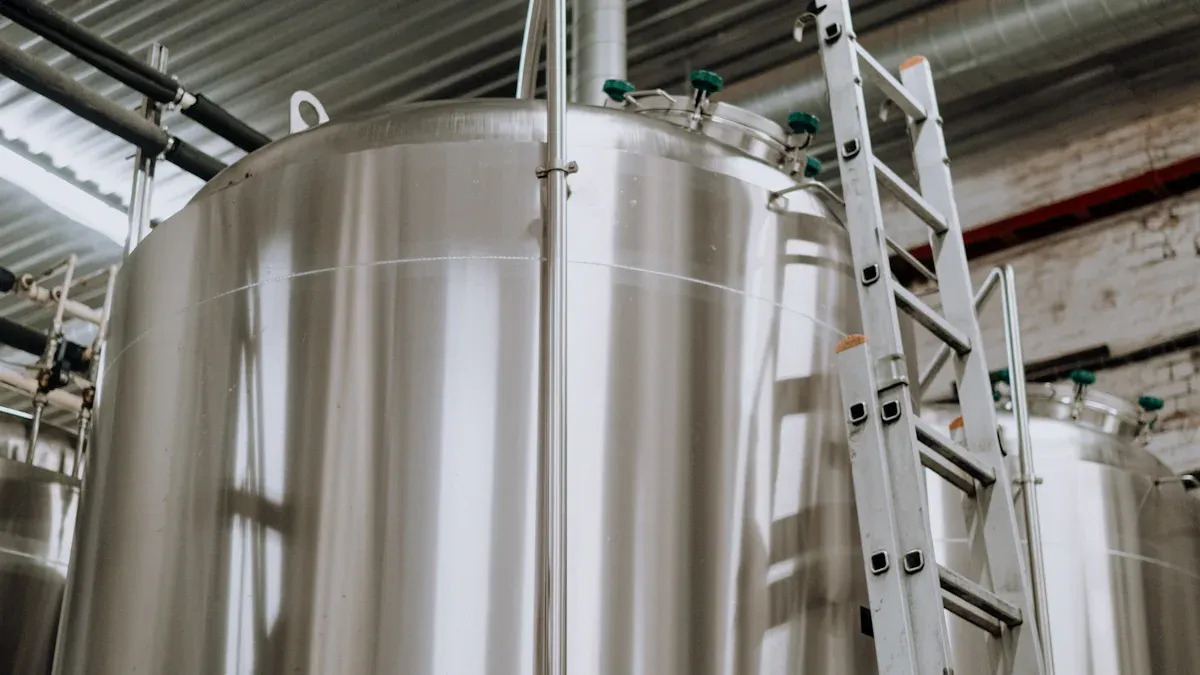
Looking for the best wine fermentation tank price online? You want to make every dollar count when you invest in fermentation tanks for your wine production. Start by knowing exactly what you need, then set your budget. The cost of a fermenter can change based on several things. Take a look at this table to see what really matters:
| Factor / Aspect | Impact on Cost Description |
|---|---|
| Quality and Capacity | Higher quality and larger capacity tanks increase initial cost |
| Scale of Production and Batch Size | Larger scale requires bigger or more tanks, raising costs |
| Supplier Pricing & Financing | Pricing varies by supplier; financing options affect upfront cost |
| Maintenance & Replacement | Regular upkeep and replacement schedules add to ongoing costs |
| Technological Sophistication | Advanced features and automation increase tank price |
| Cost-saving Strategies | Bulk purchases, leasing, preventative maintenance, and vendor negotiations can reduce costs |
You should always compare suppliers for quality, certifications, and the option to customize fermenters. Trusted names like Chenma focus on quality and technical support, so you get long-lasting fermentation tanks for your wine. Remember, the real value comes from looking at both the initial fermenter cost and what you will spend over time.
Set Budget
Assess Needs
Before you start shopping for a fermenter, you need to know what you want. Think about your wine production goals. Do you plan to make small batches or do you want to scale up with a 5 barrel fermenter? Your production volume will help you decide the right fermenter size. If you have limited space, a vertical 5 barrel fermenter can save room.
Here are some things you should consider when picking a fermenter:
- How much wine do you want to make? A 5 barrel fermenter is great for medium-sized batches.
- What space do you have? A 5 barrel fermenter fits well in most wineries.
- Do you need temperature control? Many fermenters, including a 5 barrel fermenter, come with cooling jackets.
- Is cleaning important? Stainless steel fermenters are easy to clean and resist corrosion.
- Do you want special features? Some 5 barrel fermenters have cone bottoms for easy sediment removal.
Tip: Always match your fermenter to your wine style. Red wine needs a fermenter with good cap management. White wine benefits from precise temperature control.
Estimate Fermenter Cost
Now, let’s talk about the cost. The price of a fermenter depends on size, material, and features. A 5 barrel fermenter made from stainless steel usually costs more than a plastic one, but it lasts longer and is easier to clean.
Here’s a quick look at typical price ranges for different fermenters:
| Tank Type | Typical Price Range (USD) |
|---|---|
| Stainless Steel | $1,000 to $20,000 |
| Oak Barrels | $600 to $1,500 per barrel |
| Concrete Tanks | $3,000 to $15,000 |
| Plastic Tanks | $100 to $800 |
If you want a 5 barrel fermenter, expect to pay between $1,000 and $5,000 for a good stainless steel model. Some brands offer a 5 barrel fermenter with extra features like cooling jackets or CIP cleaning systems, which can raise the cost. Always check if the fermenter cost includes shipping and accessories.
Here’s a simple list of price points you might see for a fermenter:
1. Under $100 (entry-level) 2. $100 to $199 3. $500 to $599 4. $700 to $799 5. $1,000 to $1,099 6. $1,100 to $1,199 7. $1,400 to $1,499 8. $1,500 to $1,599 9. $1,600 to $1,699 10. $2,100 and above (premium or custom 5 barrel fermenter)
When you set your budget, remember to think about both the upfront cost and the long-term value. A quality 5 barrel fermenter may cost more at first, but it can save you money over time by lasting longer and making better wine.
Research Sellers
Check Reputation
When you shop for a fermenter online, you want to trust the seller. Start by looking for companies with a strong reputation. A good seller always shares clear details about each fermenter, like size, material, and special features. You should see information about cooling jackets, cleaning options, and how the fermenter fits your wine process.
Read customer reviews. These reviews tell you if the fermenter works well and if the seller stands behind their product. A seller with many happy customers usually offers better quality. You can also check if the seller has a history of helping buyers with technical support. This support matters because you want your fermenter to last and keep its quality over time.
Here’s a quick checklist to help you spot a reputable seller:
- Shares detailed product info for every fermenter
- Has many positive customer reviews
- Offers technical support for setup and training
- Provides clear, honest pricing
- Has a proven track record in the wine industry
Tip: Always ask sellers about their experience with custom fermenter solutions. A seller who can adapt a fermenter to your needs shows real quality and care.
Review Certifications
Certifications show you that a fermenter meets strict quality standards. When you see certifications like ISO9001 and CE, you know the fermenter is safe and built to last. These marks mean the manufacturer follows rules for quality, safety, and even environmental care.
Let’s look at some top certifications you should find when buying a fermenter:
| Certification | What It Means for You |
|---|---|
| ISO9001 | Assures quality management |
| CE | Meets European safety standards |
| ISO14001 | Supports environmental responsibility |
| OHSAS18001 | Focuses on worker health and safety |
Chenma stands out because every fermenter they make holds these certifications. This means you get a fermenter that meets high quality standards and keeps your wine safe. Chenma’s technical team also helps you with installation and training, so you get the most from your fermenter.
When you choose a seller with these certifications, you protect your wine and your team. You also know your fermenter will deliver quality results for years.
Compare Wine Fermentation Tank Price
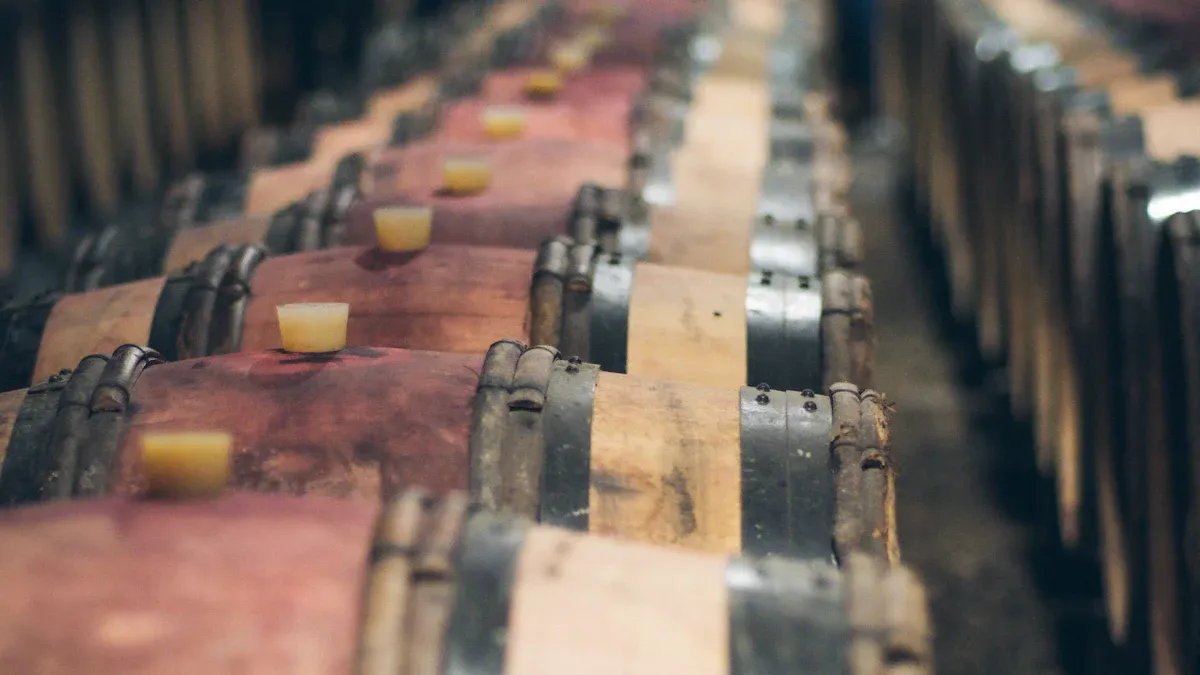
Use Price Tools
You want to get the best wine fermentation tank price, so you need to use online tools that help you compare options. Many websites, like Spectrellising.com, let you pick different fermenters and see their prices and features side by side. This makes it easy to spot which fermenter gives you the most value for your money. Some sites show prices right away, while others ask you to call for a quote. You can use the product comparison checkboxes to look at tank size, material, and special features all at once.
Stout Tanks is another supplier that lists a wide range of fermenters. Their prices start under $150 for accessories and go over $2,100 for larger tanks. You can find flat bottom, round bottom, and glycol-jacketed fermenters. They also offer both in-stock and pre-order options, so you can plan your wine production with flexibility. If you want to see how prices change with tank size, check out this chart:
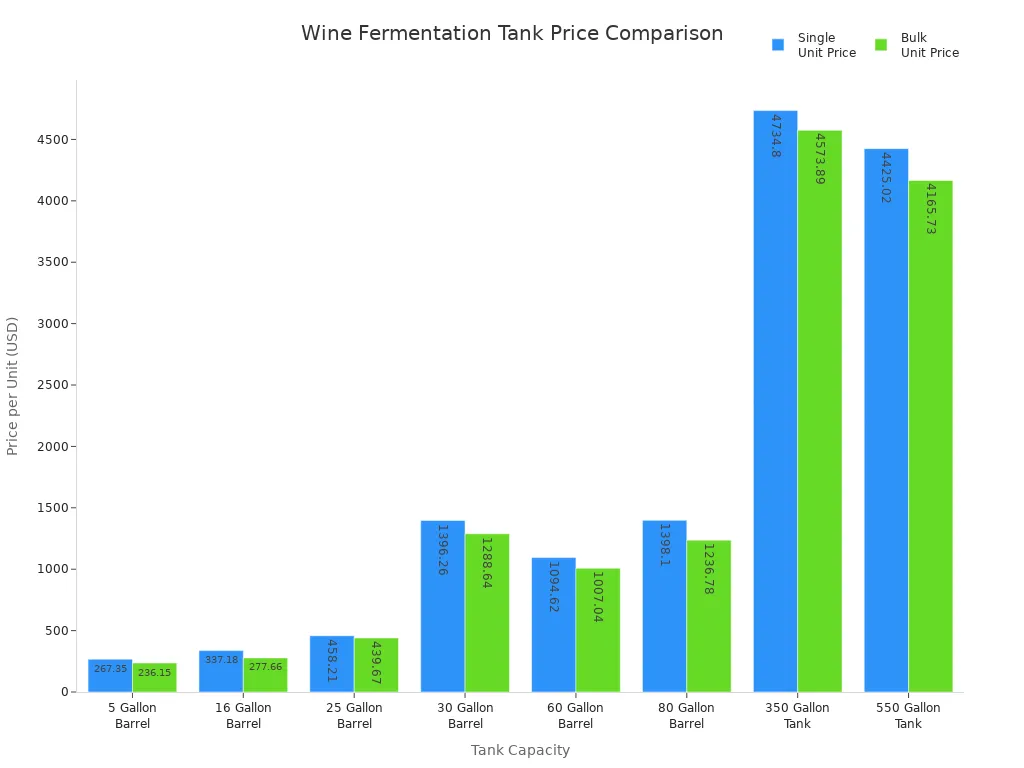
Tip: Always use online comparison tools to check the wine fermentation tank price before you buy. This helps you find the right fermenter for your wine and budget.
Analyze Features
When you compare fermenters, you need to look at more than just the price. The features of each fermenter can change the cost and the quality of your wine. Stainless steel tanks cost more, but they last longer and keep your wine safe. Oak barrels add flavor but need more care. Concrete tanks offer steady temperatures, while plastic fermenters are cheaper but less durable.
Here’s a table to help you see which features affect the wine fermentation tank price:
| Feature Category | How It Affects Cost and Quality |
|---|---|
| Tank Material | Stainless steel raises cost and quality. Oak adds flavor but needs care. Plastic is cheap but less durable. |
| Durability | Stronger tanks last longer and cost more. |
| Flavor Impact | Oak and concrete can change wine flavor, raising price. |
| Maintenance | Tanks that need more cleaning cost more over time. |
| Capacity and Size | Bigger fermenters cost more but let you make more wine. |
| Design Features | Extras like cooling jackets or adjustable lids add to cost and quality. |
| Supplier Reliability | Trusted brands may cost more but offer better quality. |
You should always match the fermenter features to your wine style and production needs. Look for quality, not just a low price. A fermenter with the right features will help you make better wine and save money in the long run.
Evaluate Fermentation Tanks
Material Options
When you look for the right fermenter, you need to think about the material first. The material you pick changes how your wine tastes, how easy it is to clean, and how long your fermentation tanks last. Most winemakers choose stainless steel for their fermenter. Stainless steel fermentation tanks cost more at the start, but they last a long time and keep your wine pure. You can clean them easily, and they do not rust. Many 5 barrel fermenter models use stainless steel because it gives you great control over temperature and keeps flavors neutral.
Some winemakers use oak barrels as a fermenter. Oak adds special flavors to your wine, but these fermentation vessels need more care. Oak barrels cost less than some stainless steel tanks, but you must replace them more often. Concrete tanks are another choice. They last a long time and help keep the temperature steady, but they need regular cleaning. Plastic fermenter options are the cheapest. They work for small batches, but they do not last as long and can hold onto smells.
Here’s a quick table to help you compare:
| Material | Price Range (USD) | Durability | Temp Control | Flavor Impact |
|---|---|---|---|---|
| Stainless Steel | $1,000–$20,000 | Very High | Excellent | Neutral |
| Oak | $600–$1,500/barrel | Medium | Low | High |
| Concrete | $3,000–$15,000 | High | Moderate | Low |
| Plastic | $100–$800 | Low | Limited | Neutral |
Tip: If you want a 5 barrel fermenter that lasts and is easy to clean, stainless steel is your best bet. Many cylindroconical tanks use stainless steel for this reason.
Size and Capacity
The size of your fermenter matters a lot. You need to match your 5 barrel fermenter to your wine production goals. Small wineries often use a 5 barrel fermenter for test batches or special wines. These fermentation tanks give you more control and let you try new ideas. If you run a mid-size winery, you might need several 5 barrel fermenter units or larger cylindroconical tanks to keep up with demand.
Here’s a table to help you pick the right size:
| Winery Scale | Recommended Tank Size | Typical Use Case |
|---|---|---|
| Boutique | ~60 gallons (~227 L) | Small batch, experiments |
| Mid-size | 600–1,000 gallons (2,271–3,785 L) | Core wines, estate lines |
| Large-scale | 5,000–10,000+ liters | Bulk production, export orders |
| Very Large | 10,000–100,000 liters | Industrial, commercial scale |
A 5 barrel fermenter holds about 155 gallons. This size works well for many wineries. If you want to grow, you can add more 5 barrel fermenter units or move to larger cylindroconical tanks. Bigger fermentation tanks cost more, but they help you make more wine at once and save money over time. Many winemakers use cylindroconical tanks because they are easy to clean and help with yeast collection.
Note: Always check if your 5 barrel fermenter or cylindroconical tanks have features like cooling jackets. These features help you control fermentation and make better wine.
Consider Fermenter Features
Cooling Jackets
When you look for a fermenter, you want to check out the features that help you make better wine. Cooling jackets are one of the most important features you can get for your 5 barrel fermenter. These jackets wrap around the fermenter and let you control the temperature during every stage of fermentation. You might see cooling jackets as double walls with fins, internal coils, or even external sweaters. Each design helps you keep your wine at the perfect temperature.
If you use a 5 barrel fermenter with cooling jackets, you can adjust the temperature for alcoholic fermentation, malolactic fermentation, and even for aging. This means you get more control over yeast activity and flavor. Tanks with these features usually cost more because they need extra plumbing and electrical work. For example, a small 5 barrel fermenter with cooling jackets can cost between $1,500 and $6,000. Larger fermenters with these features can go up to $30,000, especially if you add automation or remote monitoring.
Tip: Cooling jackets in your 5 barrel fermenter help you make wine that tastes just the way you want. You can avoid problems like stuck fermentation or off-flavors.
Many stainless steel fermenters come with cooling jackets as standard features. If you want to make high-quality wine, you should look for a 5 barrel fermenter with this feature. It is worth the investment for better results.
Space-Saving Design
Space matters when you pick a fermenter, especially if you run a small winery. Some 5 barrel fermenter models come with space-saving features that help you fit more tanks in your cellar. Square fermenters use space better than round ones, so you can increase your capacity without needing a bigger building. Stackable fermenters are another smart choice. You can move, stack, and store them easily, which saves you time and effort.
A 5 barrel fermenter with a space-saving design also helps you cut down on water and energy use. Cleaning and temperature control become easier and cheaper. These features lower your costs and help you run your winery more efficiently. You can find small stackable fermenters for $500 to $3,000, while medium ones cost $3,000 to $15,000. The right features in your 5 barrel fermenter make a big difference in how much wine you can produce and how much money you save.
Note: If you want to grow your winery, choose a 5 barrel fermenter with stackable or square features. You will get more out of your space and keep your costs down.
Check Discounts and Deals
Seasonal Offers
You can save a lot of money if you watch for seasonal offers when you buy a fermenter. Many suppliers run special deals during certain times of the year. For example, you might see discounts during harvest season or at the end of the year. Some companies offer a lower price on a fermenter when they launch a new model. You may also find deals during trade shows or online sales events.
Here is a quick list of times when you should check for fermenter discounts:
- 🍇 Grape harvest season (August to October)
- 🎉 End-of-year clearance sales
- 🛒 Black Friday and Cyber Monday
- 🏷️ New product launches
Tip: Sign up for newsletters from your favorite fermenter suppliers. You will get alerts about flash sales and limited-time offers. This helps you grab a fermenter at the best price before the deal ends.
Bulk Savings
If you plan to buy more than one fermenter, you can unlock even bigger savings. Many manufacturers give you a better price per fermenter when you order in bulk. This works well if you run a growing winery or want to upgrade your equipment all at once. Some suppliers even offer free shipping or extra accessories when you buy several fermenters together.
Check out this table to see how bulk orders can lower your cost per fermenter:
| Number of Fermenters | Price per Fermenter (USD) | Total Savings |
|---|---|---|
| 1 | $2,000 | $0 |
| 3 | $1,850 | $450 |
| 5 | $1,700 | $1,500 |
| 10 | $1,500 | $5,000 |
You should always ask the supplier if they have bulk pricing. Sometimes, you can also get a custom fermenter package that fits your needs. This makes it easier to expand your winery and keep your costs down.
Note: When you buy in bulk, check if the fermenter comes with a warranty or technical support. This adds value to your purchase and keeps your wine production running smoothly.
Calculate Total Cost
Shipping Fees
When you buy a fermenter online, shipping fees can surprise you. These tanks are big and heavy, so shipping costs stay high no matter where you order from. Some customers say shipping is expensive whether the supplier is close by or far away. You should always ask the seller about the shipping fee before you buy your fermenter. Sometimes, the delivery date and price are negotiable, so it helps to talk with the supplier.
Here’s a quick look at common extra costs you might see:
| Additional Cost Type | Description |
|---|---|
| Shipping Fee | Must be discussed and agreed with the supplier |
| Crating Charge | $50.00 added before shipping |
| Freight/Shipping Fee | Calculated after you place your order |
| Free Shipping | Usually not available for fermenters |
You might see a crating charge on your bill. This covers the special box or frame that keeps your fermenter safe during shipping. After you order, the supplier will contact you with the final shipping cost. Most sellers do not offer free shipping for these tanks. Always add these costs to your budget so you know the real price of your fermenter.
Tip: Ask for a full quote that includes shipping, crating, and any other fees before you pay for your fermenter.
Warranty and Returns
You want to protect your investment in a fermenter, so check the warranty and return policy before you buy. Most sellers offer a warranty that covers defects in materials or workmanship. For example, some companies give you a one-year warranty for galvanized steel tanks and up to five years for stainless steel tanks. You must tell the seller about any problems soon after you find them, usually within 10 days.
Returns can be tricky. You need to get permission first and fill out a return form. The fermenter must be brand new, unused, and in its original packaging. You have to return it within 30 days of the invoice date. Some items, like custom tanks or used equipment, cannot be returned. If you do return a fermenter, you might pay a 25% restocking fee and cover the shipping costs.
Here’s a table to help you see what to expect:
| Policy Aspect | Details |
|---|---|
| Warranty Duration | 1–5 years, depending on tank type and registration |
| Return Conditions | Must be new, unused, in original packaging, and returned within 30 days |
| Restocking Fee | 25% of the purchase price |
| Non-returnable Items | Custom, used, or altered fermenters; some equipment categories |
Note: Always read the warranty and return policy carefully. This helps you avoid surprises and keeps your fermenter purchase stress-free.
Negotiate with Sellers
Request Quotes
You want the best deal on your 5 barrel fermenter. Start by asking for quotes from several sellers. When you request a quote, give clear details about the 5 barrel fermenter you need. List the size, material, and any special features. Sellers can give you a better price when they know exactly what you want.
Many sellers expect you to negotiate. You can ask if they offer discounts for buying more than one 5 barrel fermenter. Some sellers have special prices for bulk orders. If you plan to buy other equipment, mention that too. Sellers may lower the price if you bundle your 5 barrel fermenter with other items.
Here are some smart ways to negotiate for your 5 barrel fermenter:
- Ask about leasing options if you want to lower your upfront cost.
- See if the seller offers a maintenance contract for your 5 barrel fermenter.
- Build a good relationship with the seller. Friendly buyers often get better deals.
- Check if the seller can include shipping or accessories with your 5 barrel fermenter.
Tip: Always get your 5 barrel fermenter quote in writing. This helps you compare offers and avoid surprises.
Price Matching
You can use price matching to save money on your 5 barrel fermenter. If you find a lower price for the same 5 barrel fermenter from another seller, ask your preferred seller to match it. Many sellers want your business and will try to beat a competitor’s price.
Show the seller proof of the lower price. This could be a screenshot or a written quote. Make sure the 5 barrel fermenter models are the same. Sellers may also match prices if you buy more than one 5 barrel fermenter or add other equipment to your order.
Here is a simple table to help you track price matching for your 5 barrel fermenter:
| Seller Name | Quoted Price | Matched Price | Extras Included |
|---|---|---|---|
| Seller A | $2,000 | $1,900 | Free shipping |
| Seller B | $1,950 | $1,950 | Extra fittings |
| Seller C | $2,100 | $1,950 | Maintenance kit |
Note: Always check the details. Make sure your 5 barrel fermenter comes with the same features and warranty when you use price matching.
Customize with Manufacturers
Custom Fermentation Tanks
When you work directly with a manufacturer like Chenma, you get the chance to design fermentation tanks that fit your winery perfectly. You can choose the size, shape, and features that match your wine goals. Maybe you want a small tank for test batches or a large one for big production runs. You can even pick tanks for red, white, or sparkling wine.
Here’s a table showing some ways you can customize your tank:
| Customization Aspect | Description |
|---|---|
| Capacity | From 100 liters to several thousand liters |
| Fermentation Style | Red, white, or sparkling wine designs |
| Tank Shape | Cylindrical, conical, or square |
| Temperature Control | Jackets for heating or cooling |
| Oxygen Management | Gas-tight seals and inert gas systems |
| Monitoring Systems | Sensors for temperature, pressure, and more |
| Ease of Use Features | Manways, drain valves, safety locks |
| Specific Designs | Open tops, floating lids, moveable tanks |
| Branding | Custom logos, packaging, and graphics |
You can also add your own logo or special graphics to your fermentation tanks. This helps your brand stand out and gives your winery a professional look.
Tip: When you talk with the manufacturer, share your ideas and needs. The more details you give, the better they can build the right tank for you.
Technical Support
Working with a company like Chenma means you get more than just equipment. You get a team that supports you every step of the way. Chenma’s engineers help you design tanks that fit your space and process. They come to your site to help with setup and make sure everything works right.
You also get:
- Ongoing technical support for any questions about your fermentation tanks.
- Life-long service, so you always have help when you need it.
- A 5-year warranty with free repairs for wine or cider tanks.
- On-site guidance from experienced brewers during your first production run.
- Friendly customer service by WhatsApp or email.
This kind of support makes your winemaking easier and helps you avoid problems. You can focus on making great wine while experts handle the technical details.
Note: Direct collaboration with manufacturers means you get tanks that match your needs and a support team that cares about your success.
Read User Experiences
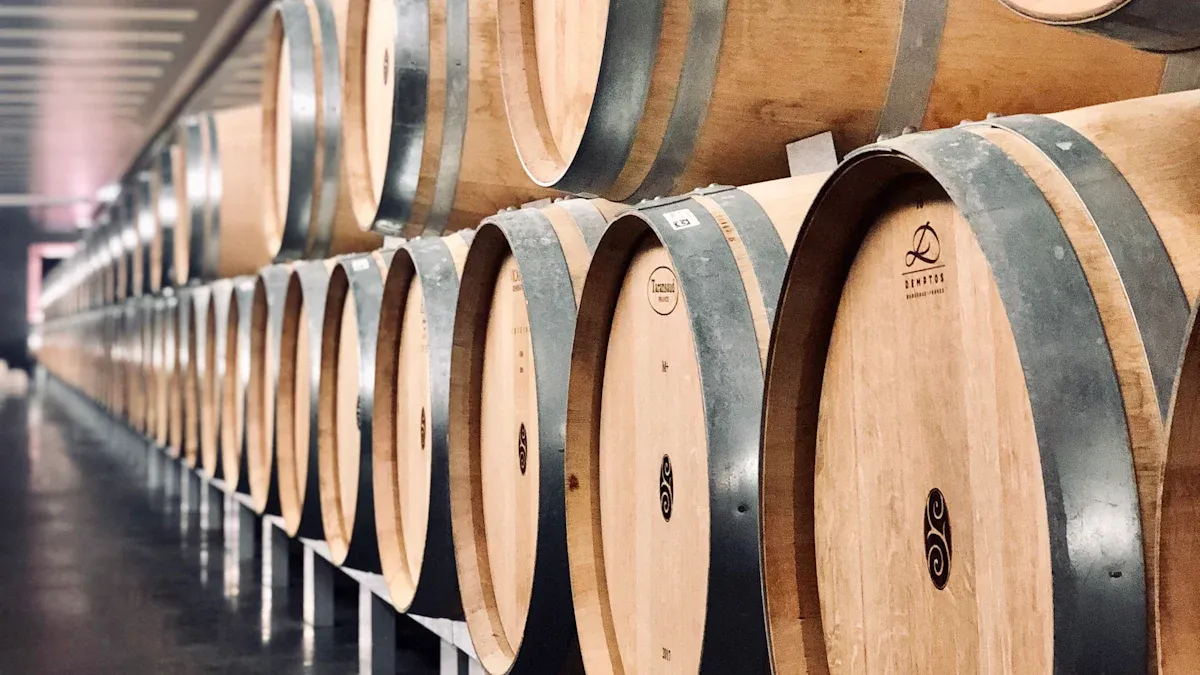
Customer Reviews
When you shop for a wine fermentation tank online, you want to know what other people think. Customer reviews give you a real look at how these tanks work in everyday wine making. Many buyers talk about the high quality of the stainless steel and the tight seals. They say these tanks feel strong and last a long time.
You will see that most reviews mention the value of included accessories. People like getting a thermometer, ball valve, and air-lock with their tank. These extras make it easier to start your wine project right away. Users also say the tanks are easy to clean and arrive well-packaged and on time.
Here are some things customers often mention:
- The tank is a big upgrade from glass carboys, especially with features like a conical bottom and tri-clamp ports.
- Cleaning is simple, which saves time during wine production.
- Most reviews give 4 or 5 stars, with high marks for price, quality, features, and ease of use.
- Some buyers notice small issues, like a tap that needs plumber’s tape or uncapped leg bottoms, but they fix these quickly.
- People feel the tanks match what the seller promises and appreciate good customer service.
You can trust these reviews to help you pick the right tank for your wine needs.
Online Forums
Online forums are a great place to learn from other wine makers. People share their real experiences and ask questions about buying and using fermentation tanks. You will find lots of helpful advice about choosing the right tank for your wine.
Common topics include:
- Picking the best tank for fermentation, cold settling, or red and white wine processing.
- Deciding on valve and manway size for easy wine transfer and cleaning.
- Making sure the cooling jacket design fits your temperature control needs.
- Checking the quality of the stainless steel, welds, and finish.
- Planning for tank height, ceiling space, and where to put the tank in your winery.
- Thinking about lead time, since some tanks take months to arrive.
People also talk about the good things they find:
- Tanks with multiple manways and adjustable legs work for many wine styles.
- Electronic temperature controls, even wireless ones, make wine making easier.
- Detailed technical drawings from trusted companies help you get the right fit.
- Careful planning and picking a good supplier save money and make your wine process smoother.
You can use these forum tips to avoid mistakes and get the best results for your wine.
You can get the best wine fermentation tank price by following a few smart steps. Always focus on quality—choose tanks made from strong stainless steel for better wine and long-lasting use. Look for certifications like ISO 9001 and CE to make sure your tank meets safety rules. Good after-sales support, such as warranties and spare parts, keeps your wine production running smoothly. Compare tank size, features, and supplier reputation. When you work with trusted manufacturers like Chenma, you protect your wine and get the most value for your money.
FAQ
What is the best material for a wine fermentation tank?
Stainless steel works best for most wineries. It lasts a long time, resists rust, and is easy to clean. You get pure flavors and strong tanks. Many winemakers trust stainless steel for both small and large batches.
How do I know if a tank meets safety standards?
Look for certifications like ISO9001 and CE. These show the tank passed strict tests for quality and safety. You can ask the seller for proof or check their website for certification details.
Can I customize my wine fermentation tank?
Yes! You can choose the size, shape, and features you want. Many manufacturers, like Chenma, offer custom tanks. You can add cooling jackets, special valves, or even your logo.
Do I need a cooling jacket on my fermenter?
If you want to control fermentation temperature, a cooling jacket helps a lot. It keeps your wine at the right temperature. This means better flavor and fewer problems during fermentation.
How long does shipping usually take for a fermentation tank?
Shipping times vary. Most tanks arrive in 2 to 8 weeks. Custom tanks may take longer. Always ask your supplier for an estimated delivery date before you order.


